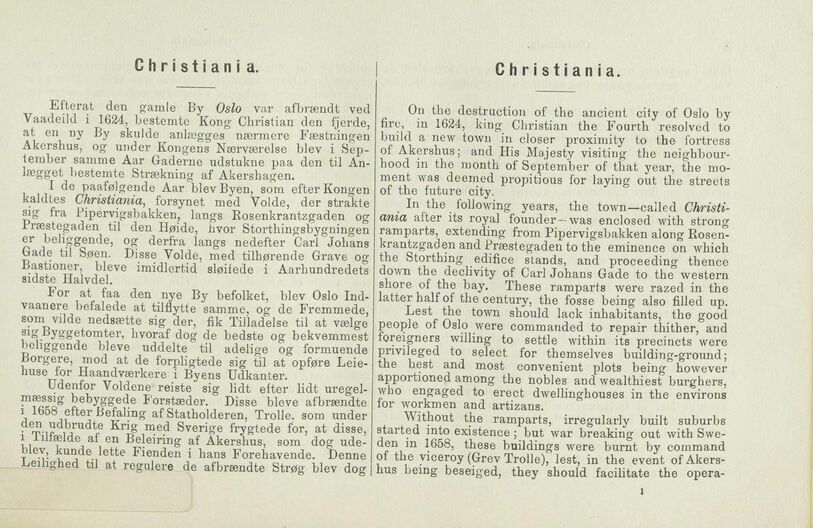
Full resolution (JPEG) - On this page / på denna sida - Sidor ...

<< prev. page << föreg. sida << >> nästa sida >> next page >>
Below is the raw OCR text
from the above scanned image.
Do you see an error? Proofread the page now!
Här nedan syns maskintolkade texten från faksimilbilden ovan.
Ser du något fel? Korrekturläs sidan nu!
This page has never been proofread. / Denna sida har aldrig korrekturlästs.
Christiani a.
Christiania.
Efterat den gamle By Oslo var afbrændt ved
Vaadeild i 1624, bestemte Kong Christian den fjerde,
at en ny By skulde anlægges nærmere Fæstningen
Akershus, og under Kongens Nærværelse blev i
September samme Aar Gaderne udstukne paa den til
Anlægget bestemte Strækning af Akershagen.
I de paafølgende Aar blev Byen, som efter Kongen
kaldtes Christiania, forsynet meel Yolde, der strakte
sig fra Pipervigsbakken, langs Rosenkrantzgaden og
Præstegaden til den Høide, hvor Storthingsbygningen
er beliggende, og derfra langs nedefter Carl Johans
Gade til Søen. Disse Volde, med tilhørende Grave og
Bastioner, bleve imidlertid sløifede i Aarhundredets
sidste Halvdel.
For at faa den nye By befolket, blev Oslo
Indvaanere befalede at tilflytte samme, og de Fremmede,
som vilde nedsætte sig der, fik Tilladelse til at vælge
sig Byggetomter, hvoraf dog de bedste og bekvemmest
beliggende bleve uddelte til adelige og formuende
Borgere, mod at de forpligtede sig til at opføre
Leie-huse for Haandværkere i Byens Udkanter.
Udenfor Voldene reiste sig lidt efter lidt
uregelmæssig bebyggede Forstæder. Disse bleve afbrændte
i 1658 efter Befaling af Statholderen, Trolle, som under
den udbrudte Krig med Sverige frygtede for, at disse,
i Tilfælde af en Beleiring af Akershus, som dog
udeblev, kunde lette Fienden i hans Forehavende. Denne
Leilighed til at regulere de afbrændte Strøg blev dog
On the destruction of the ancient ciiy of Oslo by
fire, in 1624, king Christian the Fourth resolved to
build a new town in closer proximity to the fortress
of Akershus; and His Majesty visiting the
neighbourhood in the month of September of that year, the
moment was deemed propitious for laying out the streets
of the future city.
In the following years, the town—called
Christiania after its royal founder —was enclosed with strong
ramparts, extending from Pipervigsbakken along
Rosenkrantzgaden and Præstegaden to the eminence on which
the Storthing edifice stands, and proceeding thence
down the declivity of Carl Johans Gade to the western
shore of the bay. These ramparts were razed in the
latter half of the century, the fosse being also filled up.
Lest the town should lack inhabitants, the good
people of Oslo were commanded to repair thither, and
foreigners willing to settle within its precincts were
privileged to select for themselves building-ground;
the best and most convenient plots being however
apportioned among the nobles and wealthiest burghers,
who engaged to erect dwellinghouses in the environs
for workmen and artizans.
Without the ramparts, irregularly built suburbs
started into existence; but war breaking out with
Sweden in 1658, these buildings were burnt by command
of the viceroy (Grev Trolle), lest, in the event of
Akershus being beseiged, they should facilitate the opera-
<< prev. page << föreg. sida << >> nästa sida >> next page >>